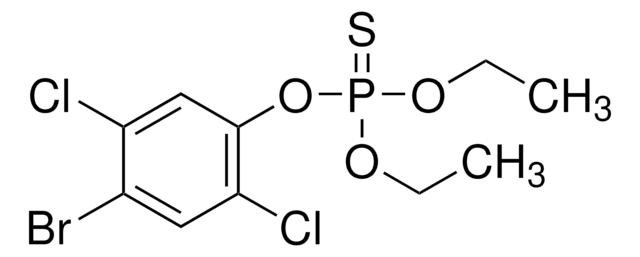About This Item
おすすめの製品
グレード
analytical standard
品質水準
製品種目
PESTANAL®
シェルフライフ
limited shelf life, expiry date on the label
濃度
100 ng/μL in methanol
テクニック
HPLC: suitable
gas chromatography (GC): suitable
アプリケーション
agriculture
environmental
フォーマット
single component solution
保管温度
2-8°C
SMILES記法
CCCC1COC(Cn2cncn2)(O1)c3ccc(Cl)cc3Cl
InChI
1S/C15H17Cl2N3O2/c1-2-3-12-7-21-15(22-12,8-20-10-18-9-19-20)13-5-4-11(16)6-14(13)17/h4-6,9-10,12H,2-3,7-8H2,1H3
InChI Key
STJLVHWMYQXCPB-UHFFFAOYSA-N
アプリケーション
法的情報
適切な製品が見つかりませんか。
製品選択ツール.をお試しください
シグナルワード
Danger
危険有害性情報
危険有害性の分類
Acute Tox. 3 Dermal - Acute Tox. 3 Inhalation - Acute Tox. 3 Oral - Flam. Liq. 2 - STOT SE 1
ターゲットの組織
Eyes,Central nervous system
保管分類コード
3 - Flammable liquids
WGK
WGK 2
引火点(°F)
51.8 °F - closed cup
引火点(℃)
11 °C - closed cup
個人用保護具 (PPE)
Eyeshields, Faceshields, Gloves
適用法令
試験研究用途を考慮した関連法令を主に挙げております。化学物質以外については、一部の情報のみ提供しています。 製品を安全かつ合法的に使用することは、使用者の義務です。最新情報により修正される場合があります。WEBの反映には時間を要することがあるため、適宜SDSをご参照ください。
消防法
第4類:引火性液体
アルコール類
危険等級II
労働安全衛生法名称等を表示すべき危険物及び有害物
名称等を表示すべき危険物及び有害物
労働安全衛生法名称等を通知すべき危険物及び有害物
名称等を通知すべき危険物及び有害物
Jan Code
45899-VAR:
45899-10ML:4548173906539
45899-1ML:4548173267968
45899-2ML:4548173906546
45899-BULK:
ライフサイエンス、有機合成、材料科学、クロマトグラフィー、分析など、あらゆる分野の研究に経験のあるメンバーがおります。.
製品に関するお問い合わせはこちら(テクニカルサービス)


